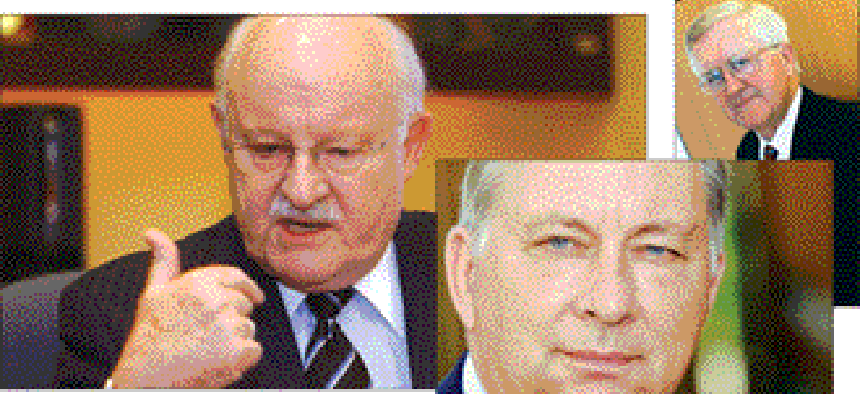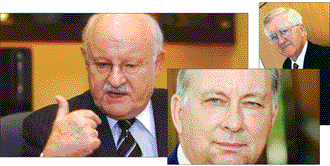Market adjustment

Procurement reform, national security and acquisitions drive 20 years of evolution.
In April 1986, as the first edition of a new business publication called Washington Technology went to press, the Information Technology Age was just getting under way. The country was still absorbing the impact of AT&T Corp.'s breakup two years earlier. Congress had passed the U. S. Computer Fraud and Abuse Act, the first wide-ranging legislation for the prosecution of crimes committed through and against computer systems. And although IBM Corp.'s personal computer had been around for five years, the PC still had not become ubiquitous on desktops.In the 20 years since, IT has transformed the federal government, the largest buyer of IT products and services in the world. In fiscal 1986, the U.S. government spent $45.5 billion in "then-year" dollars on all things IT, including employees, contract services, hardware, software, systems and IT embedded in weapons systems, according to FedSources Inc. For fiscal 2006, FedSources said, the figure is $105.1 billion.Washington Technology asked veterans of the IT community, including executives, government officials, consultants and policymakers, about the critical moments and events that shaped the market. The successes, setbacks and lessons learned are many but four primary themes emerged: national security, legislation, major procurements and corporate mergers and acquisitions.In the mid-1980s, the hot opportunity for systems integrators was communications technology and networks for President Reagan's Strategic Defense Initiative, dubbed Star Wars. The Cold War's demise dashed that business prospect, but with the first Gulf War in 1990 and other conflicts such as that in Kosovo, new opportunities came. Companies such as CACI International Inc. moved into IT, providing troops with computers, communications, logistics and support services.Civilian agencies, especially in the national security arena, picked up on the Defense Department's use of IT as a critical enabler and applied it to the business of government over the last 10 to 15 years, said Stan Soloway, president of the Professional Services Council industry group, and a Washington Technology columnist.The onset of the Global War on Terrorism, following the Sept. 11 terrorist attacks, and the subsequent U.S. invasions of Afghanistan and Iraq, along with the Bush administration's defense transformation efforts, boosted demand for more sophisticated systems, newer platforms and coordinated disaster response networks. The military increased its need for command, control, communications, computers and intelligence (C4I) systems that connected to each other. The drive for network-centric operations and interoperable systems gained even more momentum, a trend that continues to this day."There have been more and more contracts going out to industry to provide these specialized high-tech services, especially in the IT arena," for both the military and the intelligence community, said J.P. "Jack" London, CACI's chairman, president and CEO and a 35-year veteran of the Arlington, Va., company.1996 was a watershed year for the IT industry as Congress passed the Clinger-Cohen Act and the Telecommunications Act."Many Washington Technology readers remember a time when the most important aspect of IT acquisition was the acquisition process itself and not the technology," said Rep. Tom Davis (R-Va.), chairman of the House Government Reform Committee. Davis was instrumental in passing Clinger-Cohen during his early years in Congress, and acquisition reform remains one of his top priorities. "The technology requirements of government were effectively subordinated to the process by which the technology was bought. And that was wrong," He said.Congress reformed the process with passage of the Clinger-Cohen Act, which brought a "disciplined technology acquisition and management framework so that information could be more effectively coordinated and moved across government," Davis said.The act required that government IT shops treat technology acquisition, planning and management as a capital investment. Clinger-Cohen replaced the Brooks Act, which required GSA to approve all computer-related programs. Under the Brooks Act, contracts could take three to four years to award, said Olga Grkavac, executive vice president of the Information Technology Association of America, a trade group in Arlington, Va.Clinger-Cohen focused attention on the critical role of IT and the management related to integrating it into government operations. It also created the role of the chief information officer in the government and mandated the interagency CIO Council."This was the mid-1990s, and IT was really exploding as the great enabler of dramatically different processes, ways of achieving greater efficiency and higher quality," PSC's Soloway said.The Telecommunications Act of 1996 was the first major overhaul of U.S. telecom regulations in 62 years. The major long-distance carriers wanted to offer local calling services, the traditional territory of the regional Bell operating companies, and the regional Bell operating companies wanted to infiltrate the long-distance market."It changed the landscape indelibly and ? it was complex and overdue," said James Payne, now president of federal telecom at Bechtel Systems and Infrastructure Inc., but a Sprint Corp. employee at the time. "It was a great leap that we took to make a resolution of it."The act opened the way for traditional telecom carriers to expand into systems integration and operations and management, while IT companies started getting into the telecom business, said Charles Viator, Jr., vice president of federal sales at Rivulet Communications Inc., an IP network technology provider.Convergence of telecom and IT companies "has changed the face of information technology acquisition, deployment and success to a great extent," said Viator, who has worked in government IT and telecom contracting for more than 40 years.Major projects, such as the Defense Department's Project Viable and Global Command and Control System (GCCS) have shaped the government IT market since 1986, experts said.The Vertical Installation Automation Baseline contract, known as Project Viable, was an Army program that replaced obsolete 1960s technology with modern automated data processing equipment. In 1982, the Army awarded EDS Corp. the 10-year, $600 million contract to build and operate the system.The contract was the first major systems integration procurement and the first of the modern age IT programs, ITAA's Grkavac said.Started by the Navy in the early 1990s, the GCCS project created an automated C4I system for crisis planning and combat support. In 1996, the Joint Chiefs of Staff designated it the Defense Department's system of record, and DOD continues to add capabilities to it, said Ray Bjorklund, senior vice president and chief knowledge officer of FedSources"Being able to put together a system like that has been a great boon to the government," Bjorklund said. "They're still spending hundreds of millions [of dollars] on those capabilities as they upgrade them."On the civilian side, the General Services Administration's 10-year Federal Technology Services 2000 contract was a milestone when it was awarded in 1988 to AT&T and Sprint because it outsourced the government's telecom services and eventually drove prices down to pennies a minute for service, said Robert Woods, president of Topside Consulting Group LLC."That procurement was a watershed," he said. The contract offered government agencies voice, video, e-mail and high-speed data communications on a digital fiber-optic network. "It changed how we bought telecommunications, the pricing and the idea that government could aggregate its buying power." Woods, who served about 30 years in the federal government, retired as GSA's FTS commissioner.The Navy-Marine Corps Intranet contract stands out as a huge federal project that ran amok, before its contractor EDS pulled it back from the brink of utter disaster.Awarded to the company in October 2000, the $6.9 billion contract was to provide the Navy with a range of network-based information services on a single, enterprisewide intranet. It gave secure access to integrated voice, video and data communications.EDS had to build a new computer network to replace hundreds of old networks and thousands of legacy applications that had to be modernized, said Bill Loomis, a managing director at Stifel, Nicholaus and Co. Inc. who covers defense and government IT companies. He also is a Washington Technology columnist.But the Navy greatly underestimated the number of applications that need to be supported or replaced. Because the contract was fixed price, EDS had to foot the bill upfront for new computer hardware, software and labor. The cost over several years was measured in the billions of dollars."Costs can explode when you literally have tens of thousands more applications scattered across naval locations across the country that have to be examined line by line, rewritten in new software and replaced," Loomis said.From NMCI, contractors learned the importance of doing well-documented due diligence and ensuring that the contract's language is in cost-plus payment terms for any unknown variables, Loomis said. "You can't take the government's or the client's word on it," he said.In the late 1980s and early 1990s, merger and acquisition activities concentrated in the defense market as spending on weapon systems contracted. But the defense and aerospace companies quickly turned their attention to IT with the rise of network centric operations.Companies such as Lockheed Martin Corp., Northrop Grumman Corp. and General Dynamics Corp. made major acquisitions to build their IT capabilities."You have all the big aerospace companies saying that's where the money is going, and we need to be in it," said Ray Oleson, co-founder and chairman of SI International Inc. of Reston, Va.SI is one of many IT companies that became active acquirers, particularly in the past decade. Other major IT buyers include CACI, ManTech International Inc., Science Applications International Corp. and SRA International Inc.The market also has seen the entrance of foreign buyers, particularly from the United Kingdom. BAE Systems plc of Farnborough, U.K., in particular has been an aggressive buyer, usually closing a deal or two each year.Dealmaking by a variety of players will continue to shape and influence the market."It has changed the landscape, and it continues to change it as we speak," Oleson said.Staff Writer Roseanne Gerin can be reached at rgerin@postnewsweektech.com.

A demand arises
Focus shifts to it's role
An error in judgement

J.P. "Jack" London, CACI; Robert Woods, Topside Consulting Group LLC; Ray Oleson, SI International.
Olivier Douliery (London), Rick Steele (Woods, Oleson)
A demand arises
Focus shifts to it's role
An error in judgement
NEXT STORY: The past points to our future

